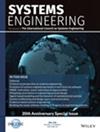Integration of systems design and risk management through model‐based systems development
IF 1.6
3区 工程技术
Q4 ENGINEERING, INDUSTRIAL
引用次数: 0
Abstract
Model‐based systems engineering is a powerful methodology to develop safety‐critical systems. The use of the system model as a single source of truth for risk and dependability analysis results in a consistent and complete assessment. Besides, representation and logging of the assessment within the model result in a complete and up‐to‐date single source of information that can be used during the device certification as well. This paper aims to provide a comprehensive risk management SysML profile that includes interconnected safety analysis [functional hazard assessment (FHA), fault tree, and failure mode and effect analysis (FTA, FMEA)], control measure, and evaluation model elements in compliance with the medical standards. Model‐based risk assessment of a point‐of‐care diagnostic device for sepsis has been shown as a case study to show the implementation of the profile. This device is a standalone unit and the test results obtained directly affect the patient. Therefore, both the top‐down (FHA and FTA) and bottom‐up (FMEA) safety assessment methods have been used. Another objective of the study is to define a systematic and holistic method to perform fault tree analysis, not only from the system architecture models but also from the functional, activity, and sequence diagrams of the system model.通过基于模型的系统开发实现系统设计和风险管理的集成
基于模型的系统工程是开发安全关键系统的有力方法。使用系统模型作为风险和可靠性分析的单一事实来源,可以得到一致和完整的评估。此外,模型中评估的表示和记录可以形成一个完整的、最新的单一信息源,也可以在器械认证期间使用。本文旨在提供一个综合的风险管理SysML概要,包括互连的安全分析[功能危害评估(FHA),故障树,故障模式和影响分析(FTA, FMEA)],控制措施,以及符合医学标准的评价模型要素。基于模型的脓毒症点护理诊断设备的风险评估已被显示为一个案例研究,以显示该概况的实施。该设备是一个独立的单元,所获得的测试结果直接影响患者。因此,采用了自顶向下(FHA和FTA)和自底向上(FMEA)两种安全评估方法。本研究的另一个目标是定义一个系统和整体的方法来执行故障树分析,不仅从系统架构模型,而且从系统模型的功能图、活动图和序列图。
本文章由计算机程序翻译,如有差异,请以英文原文为准。
求助全文
约1分钟内获得全文
求助全文
来源期刊

Systems Engineering
工程技术-工程:工业
CiteScore
5.10
自引率
20.00%
发文量
0
审稿时长
6 months
期刊介绍:
Systems Engineering is a discipline whose responsibility it is to create and operate technologically enabled systems that satisfy stakeholder needs throughout their life cycle. Systems engineers reduce ambiguity by clearly defining stakeholder needs and customer requirements, they focus creativity by developing a system’s architecture and design and they manage the system’s complexity over time. Considerations taken into account by systems engineers include, among others, quality, cost and schedule, risk and opportunity under uncertainty, manufacturing and realization, performance and safety during operations, training and support, as well as disposal and recycling at the end of life. The journal welcomes original submissions in the field of Systems Engineering as defined above, but also encourages contributions that take an even broader perspective including the design and operation of systems-of-systems, the application of Systems Engineering to enterprises and complex socio-technical systems, the identification, selection and development of systems engineers as well as the evolution of systems and systems-of-systems over their entire lifecycle.
Systems Engineering integrates all the disciplines and specialty groups into a coordinated team effort forming a structured development process that proceeds from concept to realization to operation. Increasingly important topics in Systems Engineering include the role of executable languages and models of systems, the concurrent use of physical and virtual prototyping, as well as the deployment of agile processes. Systems Engineering considers both the business and the technical needs of all stakeholders with the goal of providing a quality product that meets the user needs. Systems Engineering may be applied not only to products and services in the private sector but also to public infrastructures and socio-technical systems whose precise boundaries are often challenging to define.
 求助内容:
求助内容: 应助结果提醒方式:
应助结果提醒方式:


